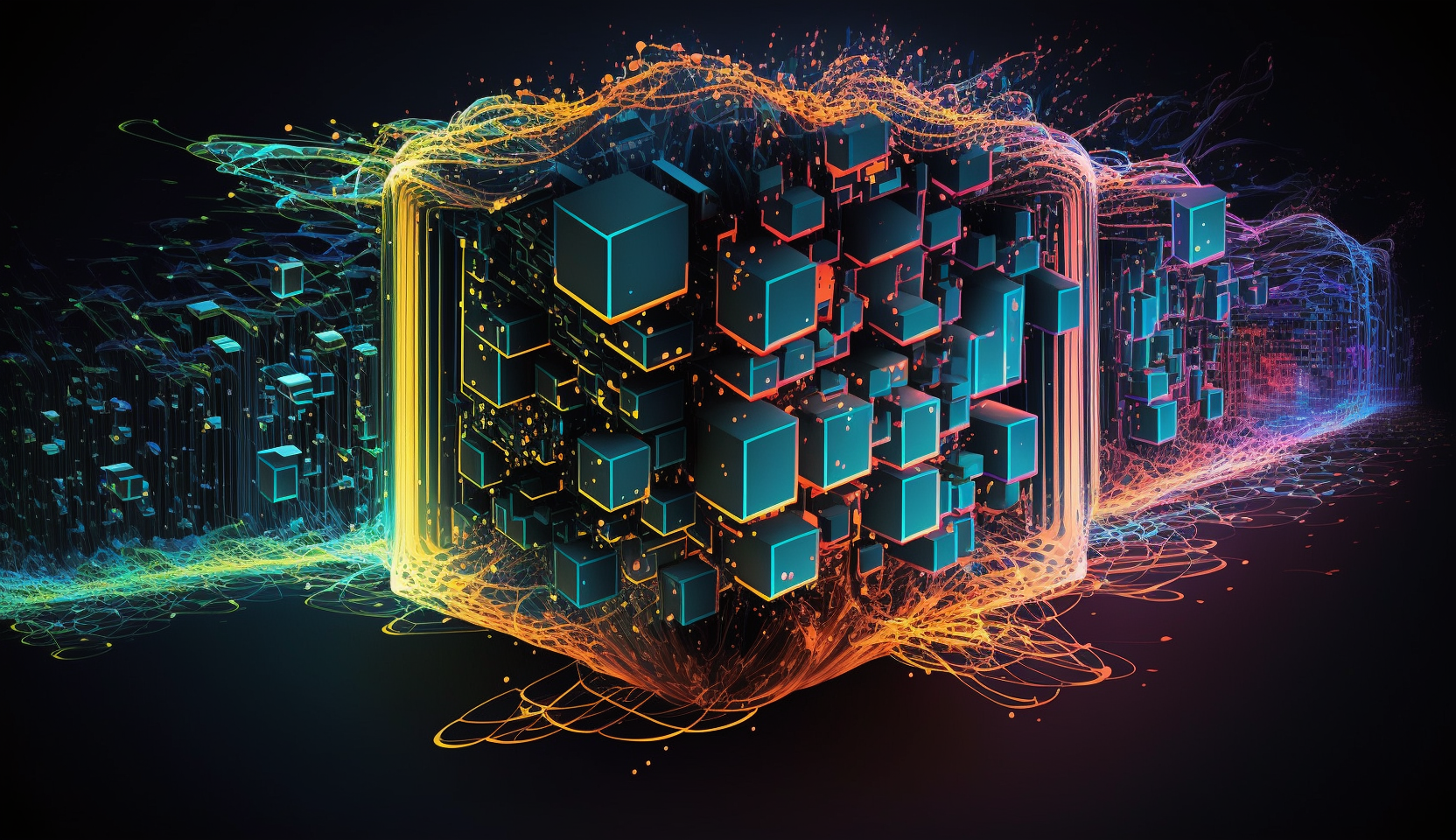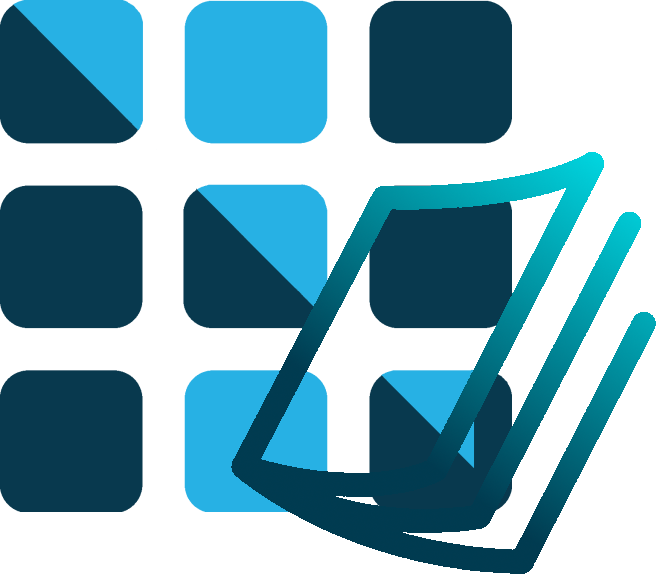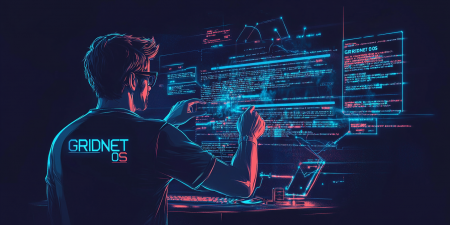Introduction
In the vast realm of blockchain technology and decentralized systems, innovative concepts continuously emerge, revolutionizing how we approach digital security, integrity, and consensus. One such concept, inherent to the GRIDNET Decentralized Operating System, is the idea of ‘checkpoints.’
Much like the checkpoint in a marathon race that ensures the runners’ correct progression, checkpoints in the context of a blockchain environment are pivotal in maintaining the integrity and accuracy of data over time, especially when operating with a decentralized state machine. In this complex system, code instructions within data blocks directly influence the state of the machine, often leading to changes in the system’s overall state or its sub-states. However, the nuances of this influence are not always straightforward, particularly when the underlying codebase or data structures evolve.
The ability to understand and operate with older versions of data structures amidst an ever-evolving software is paramount. Hence, ‘data structure translation layers’ come into play, enabling the system to ‘unpack’ and interpret older data structures correctly, thus ensuring the continuous and seamless functionality of the blockchain.

GRIDNET Team delivering each and every day. So that your business may keep moving on, uninterruptedly.
Yet, this is not enough. As the decentralized state machine processes instructions and evolves over time, the outcome of that evolution might not always be predictable or consistent, due to factors such as rounding in BigFloat processing or divisions of Big Integers. This unpredictability introduces a novel challenge: How can we ensure consistency and accuracy in such a fluid, decentralized environment?
Enter ‘checkpoints.’ These innovative constructs allow for a certain flexibility in the course of events while ensuring that the final outcome, or the ‘perspective,’ aligns with the intended result. Checkpoints are thus crucial to maintaining the integrity and correctness of the entire system.
In this article, we delve deep into the philosophy behind checkpoints, their implementation in the GRIDNET Decentralized Operating System, and their role in maintaining the consistency and integrity of the blockchain environment. Through an in-depth exploration of the decentralized state machine, the Merkle-Patricia-Trie, data structure translation layers, and the mechanisms of checkpoint activation and deactivation, we aim to provide a comprehensive understanding of these intricate concepts. Join us as we journey through the underpinnings of checkpoints in the GRIDNET Decentralized Operating System.
Background: Blockchain, Decentralized Operating System and GRIDNET
In order to understand the concept of ‘checkpoints’ and their role in the GRIDNET system, it is essential first to grasp the fundamentals of blockchain technology, decentralized operating systems, and the specific architecture of GRIDNET.
A blockchain is essentially a distributed database, often visualized as a chain of blocks, where each block contains a list of transactions. Each block is linked to the previous one through a cryptographic hash, thereby forming a chain. This unique structure ensures the immutability and transparency of the data recorded in the blockchain. Once a block is added to the chain, altering its content becomes virtually impossible without altering all subsequent blocks, which would require an immense amount of computational power. This inherent feature makes blockchain technology highly secure and resilient to data tampering.
A decentralized operating system, on the other hand, is a computational infrastructure where the resources, control, and data are not owned or managed by a single entity. Instead, these elements are distributed across a network of independent nodes, each of which participates in the consensus mechanisms and maintains a copy of the blockchain. The decentralization provides significant advantages such as censorship resistance, security against single points of failure, and enhanced privacy.
GIRDNET OS is a next-generation decentralized operating system that is built on a robust blockchain framework. It is designed to provide secure and efficient solutions for distributed applications (dApps), leveraging the unique strengths of blockchain technology. GRIDNET deploys a unique, decentralized state machine backed by a blockchain, where the state of the machine is determined by the code instructions stored within data blocks of the blockchain.
One of the fundamental aspects of GRIDNET’s architecture is the implementation of a structure known as a Merkle-Patricia-Trie, a type of tree-like data structure, to store and verify large amounts of data efficiently. This structure, along with the concept of ‘Perspective’ – a hash located within the root of the Merkle-Patricia-Trie, plays a crucial role in maintaining the system’s integrity.
Within this innovative and complex system, the concept of ‘checkpoints’ emerges as a solution to tackle the inherent challenges of maintaining data consistency and accuracy over time, especially in light of changing software or data structures. This article aims to illuminate this crucial concept, outlining how checkpoints in the GRIDNET Decentralized Operating System contribute to the overall resilience and stability of the platform.
Understanding the Decentralized State Machine
A Decentralized State Machine (DSM) lies at the heart of the GRIDNET Decentralized Operating System. It operates based on the logic encapsulated within the code instructions present in the data blocks of the blockchain. These code instructions, referred to as transactions, alter the state of the DSM, causing it to evolve over time.

In GRIDNET OS new nodes keep coming at all times. They need to be able to verify the od history of events. So that true decentralization may prevail.
The state of the DSM can be visualized as a tree, with the main state at the root and all of its sub-states branching out like leaves. This tree-like structure provides a comprehensive and hierarchical overview of the system’s state at any given time.
To implement this structure efficiently, GRIDNET uses a specific type of data structure known as a Merkle-Patricia-Trie (MPT). The MPT is a combination of a Patricia Trie, which allows for efficient storage and lookup of data, and a Merkle Tree, which adds a layer of cryptographic security.
In the MPT, each node represents a particular state or sub-state of the DSM. Each leaf node (the nodes at the very end of branches) contains unitary data structures representing unitary files on user accounts. Moving up the tree, we encounter nodes representing user accounts themselves. The root node, the topmost node of the tree, carries a ‘hash’ that is utilized to validate the integrity of all the sub-components. This hash is called a ‘Perspective.’
The Perspective provides an efficient way to confirm the integrity of the entire system state. Given that a slight change in any sub-state would lead to a change in its hash, any discrepancy in the hashes would propagate to the top of the MPT. If the resulting Perspective after processing a block doesn’t match the Perspective stated in the block, it indicates a mismatch between the expected and actual outcomes. This discrepancy could lead to the rejection of the block, thereby ensuring the system’s integrity and accuracy.
Thus, the Decentralized State Machine, visualized as a tree and implemented through a Merkle-Patricia-Trie, plays a pivotal role in the operation of the GRIDNET system. It not only enables efficient storage and validation of state changes but also serves as a guardrail for the system’s integrity.
A Deeper Look at the Merkle-Patricia-Trie
The Merkle-Patricia-Trie (MPT) is a powerful data structure that combines the best features of Patricia Tries and Merkle Trees. Understanding how it works is crucial to grasp how the GRIDNET Decentralized Operating System maintains data integrity and validates state changes.
Patricia Tries
Patricia Tries are a type of tree-like data structure that efficiently stores and looks up data. Each node in a Patricia Trie represents a piece of data, and the path to a node represents the key associated with that data. This structure allows for efficient storage and lookup, as common prefixes of keys are shared among nodes, significantly reducing storage space and speeding up data retrieval.
Merkle Trees
A Merkle Tree, on the other hand, is a tree in which every non-leaf node is labeled with the hash of the labels or hashes of its child nodes. Leaf nodes are labeled with the hash of the data block. This structure ensures that any change in data will result in a change in the hash, which will propagate up the tree, altering the root’s hash. The root hash or ‘root digest’ allows for efficient and secure verification of the contents of the tree.
Merkle-Patricia-Trie
The Merkle-Patricia-Trie (MPT) is a blend of the Patricia Trie’s storage efficiency and the Merkle Tree’s cryptographic security. It operates as a tree-like database that provides a fully cryptographically authenticated data structure. It can be used to store all (key, value) bindings, and is particularly helpful for large data structures.
Efficiency and the Merkle-Patricia-Trie
While the integrity and security of data are paramount in the blockchain technology underlying GRIDNET, the efficiency of processing and verifying this data is equally crucial for the performance and scalability of the system. A key player in achieving this efficiency is the Merkle-Patricia-Trie.
Efficient Data Retrieval
The Merkle-Patricia-Trie provides an efficient structure for storing and retrieving data. Its tree-like structure allows for quick lookups of any given data piece without having to traverse the entire dataset. This property is especially significant in the context of a large, continuously growing database like a blockchain.
Proof of Inclusion
Another efficiency aspect is related to the ability to provide a proof of inclusion for any given data element. Instead of needing the entire dataset, a proof of inclusion can be generated using only the nodes along the path to the particular leaf node (data element) in question. This proof can then be verified by any party, providing an efficient way to confirm the presence of specific data within the larger dataset without needing to share or process the complete data structure.
Reducing Storage Requirements
The Merkle-Patricia-Trie’s design also supports a reduction in storage requirements. The Trie optimizes storage by sharing common paths for different data elements. For instance, two transactions that share a common initial sequence will share the corresponding nodes in the Trie until the point of divergence. This feature can significantly reduce the storage footprint for the system, contributing to overall efficiency.
Efficient Updates
Merkle-Patricia-Tries also allow for efficient updates to the data structure. When an update is made, new nodes are created for the changed data and all of its ancestors up to the root, while the rest of the nodes remain unchanged. This process creates a new ‘perspective’ without needing to copy or alter the entire data structure, thus making the operation highly efficient.

Proper integrity of data is essential at all times.
Through these mechanisms, Merkle-Patricia-Tries not only ensure the integrity of the data within the GRIDNET Decentralized Operating System but also contribute significantly to its efficiency. The result is a system capable of handling large volumes of data while maintaining performance, a crucial aspect for any scalable, decentralized system. In the context of the GRIDNET Decentralized Operating System, the MPT holds the states of the decentralized state machine. Each leaf node stores unitary data structures that represent individual files on user accounts. A level above, the nodes represent the user accounts themselves. The root node of the tree holds a special ‘hash,’ the Perspective, which serves as the cryptographic fingerprint of the entire system state. This hash can be used to validate the integrity of all sub-components, providing a fast and efficient way to authenticate and secure data.
Changes in the state machine are reflected in the MPT. Any modifications to the data represented by leaf nodes will result in a change in their hash. This change propagates up to the root, causing a change in the Perspective. By comparing the expected and actual Perspectives, the system can validate the accuracy and integrity of state changes and detect any potential discrepancies. As such, the MPT is not merely a data structure within the GRIDNET system but serves as a fundamental mechanism for ensuring system integrity and accuracy.
Further use of Merkle-Patricia-Tries in the GRIDNET Ecosystem
The application of Merkle-Patricia-Tries (MPT) within the GRIDNET Decentralized Operating System extends beyond the main system state machine. The MPT’s ability to provide an efficient, secure, and integrity-preserving structure makes it indispensable for various aspects of the system, including user directories and blockchain blocks.
MPT in User Directories
User directories in the GRIDNET system are also represented using Merkle-Patricia-Tries. Each user’s directory forms a sub-trie within the main system trie, containing data specific to that user. Each node in these sub-tries holds unitary files belonging to the user, and the root carries a unique hash that represents the state of that specific user’s directory.
As changes occur within the user’s directory—such as file addition, deletion, or modification—the corresponding sub-trie undergoes modifications. Consequently, the hash in the root of the user’s sub-trie changes, reflecting the new state of the user’s directory. This modification ripples up to the main system trie, ensuring that the overall system state remains consistent with the user directory’s state.
MPT in Blockchain Blocks
In the context of blockchain blocks within GRIDNET, the use of MPT further extends to protecting the integrity of the block contents. Each block contains multiple pieces of data, including transactions, receipts, and other ‘verifiables’—each of which is encapsulated within a dedicated Merkle-Patricia-Trie. These dedicated MPTs act as containers that preserve the integrity of their respective data types. The root of each MPT contains a hash representing the entire set of transactions, receipts, or other ‘verifiables’ in that block. Should any component within these dedicated MPTs change, it results in a change in the corresponding root hash.
When a block is unpacked and its contents are processed, the system compares the computed root hash with the stored root hash for each dedicated MPT. If there’s a mismatch, it signals a potential issue with the integrity of the block’s data. By applying the Merkle-Patricia-Trie structure in these various facets of the system, GRIDNET ensures data integrity, efficient storage and lookup, and cryptographic security. It forms a crucial part of the architectural backbone, providing a robust, scalable, and secure structure for managing complex data within a decentralized operating system.
Data Blocks, Code, and Change Over Time
The operation of the GRIDNET Decentralized Operating System is highly dependent on the data blocks stored in the blockchain and the code instructions encapsulated within them. These data blocks carry the instructions that drive the changes in the state of the decentralized state machine. However, over time, both the code that operates the state machine and the data structures that the code operates on may change.
Evolution of Data Structures
Data structures within the GRIDNET system, such as those encapsulating transactions or receipts, are likely to evolve over time. As the system grows and develops, these structures may be updated or replaced to accommodate new features, enhance performance, or improve security. One key aspect of this evolution is the need for backward compatibility. To ensure the system can still understand and process older versions of data structures, each data structure carries an identifier of its version. This versioning allows the system to recognize and correctly interpret different versions of a data structure, preserving the ability to process older data even as the system evolves.
Data Translation Layer
To facilitate the processing of different versions of data structures, GRIDNET introduces a dedicated data structure translation layer. This layer interprets an older version of a data structure and ‘unpacks’ it into its most recent version, allowing older data to be processed by the latest code.
For example, consider a container `CTransaction` used to carry executable code. If the member field `uint64_t mERGCost` is upgraded to `BigInt mERGCost`, the translation layer ensures that the `uint64_t` value is correctly converted into the `BigInt` used in the latest version of the container.
This translation layer plays a crucial role in maintaining system compatibility and coherence throughout the evolution of the system’s codebase and data structures.
Data Integrity and Validation
However, maintaining compatibility with older data is not enough to ensure system integrity. Each block contains dedicated MPTs that hold transactions, receipts, and other ‘verifiables’. These MPTs serve to protect the integrity of the block’s contents.
During the validation process, the system must ensure that even newer containers compute their fingerprints as if they were the older version of the data structure. Any discrepancy in the computed hash and the hash contained within the block could lead to the block’s rejection. This strict validation process ensures that the system continues to maintain its integrity and accuracy even as its codebase and data structures evolve over time.
The Role of Data Structure Translation Layers
In a constantly evolving system like GRIDNET, the Data Structure Translation Layers serve as a vital tool to ensure backward compatibility and data integrity. These layers serve as bridges between older and newer versions of data structures, allowing seamless interaction and processing.

Sometimes the old needs to be translated into the new.
Facilitating Backward Compatibility
As technology advances, so does the GRIDNET Decentralized Operating System. New features are added, and enhancements are made to improve user experience and system performance. However, with these changes come the challenge of maintaining backward compatibility – the ability to interpret and process older data structures correctly.
Data Structure Translation Layers enable this backward compatibility by providing a mechanism to ‘unpack’ older versions of data structures into their newest form. By identifying the version of a data structure, the translation layer applies the necessary transformations to convert it into the latest format. This process ensures that all data, regardless of when it was created, can be accurately processed by the current system version.
Preserving Data Integrity
Data Structure Translation Layers also play a crucial role in preserving data integrity. As the data structure evolves, maintaining the original hash footprint becomes essential to validate the data’s authenticity. Even though the container has been updated, the computed hash during validation should match the older version’s hash, as if no transformation occurred. For example, if a data structure’s member field is upgraded from `uint64_t` to `BigInt`, the translation layer must ensure that the newer `BigInt` version computes its hash as if it were the `uint64_t` version. This integrity check prevents any data tampering and maintains the consistency of the system.
Ensuring System Evolution
Ultimately, Data Structure Translation Layers play an essential role in GRIDNET’s evolution. By allowing backward compatibility and preserving data integrity, these layers facilitate the system’s continuous development. As the data structures change and improve, the translation layers ensure that these modifications do not disrupt the system’s functioning or compromise its security, proving their indispensable value in the GRIDNET architecture.
Integrity Protection and Validation Challenges
As the GRIDNET Decentralized Operating System evolves over time, ensuring the integrity and authenticity of data within the system becomes a central concern. As changes occur in both the processing logic and data structures, maintaining accurate validation becomes a challenging task.
Changing Processing Logic and Data Structures
The processing logic of the system, the code that operates the decentralized state machine, may undergo changes and updates. At the same time, data structures, such as those encapsulating transactions or receipts, also evolve. These changes can potentially alter the results of computations, which in turn affect the hash fingerprints of the data.
A notable example is the alteration of numerical representation in a transaction. Suppose we replace a numerical representation from `uint64_t` to `BigInt`. This modification allows for more extensive numerical values. However, due to different computational representations and operations on these data types, this change could result in different hash footprints.
Maintaining Data Integrity Amid Changes
To maintain data integrity, any change that occurs in the computation or the data structure should not result in a discrepancy between the newly computed hash and the original hash in the data block. A mismatch would lead to the rejection of the block, as it implies potential data tampering or error in data processing.
This integrity check becomes even more challenging when considering the various data structures contained in each block. Each block contains dedicated Merkle-Patricia-Tries (MPTs) for transactions, receipts, and other ‘verifiables,’ each needing to pass this rigorous validation process. The MPT’s root hash after processing should match the original root hash for successful validation.
The Complexity of Validation
These challenges showcase the complex nature of validation within the GRIDNET system. Not only must the system handle the evolving nature of its data structures and processing logic, but it must also ensure that these changes do not compromise the system’s data integrity. In the next section, we’ll introduce the concept of ‘checkpoints’ — a novel solution proposed by GRIDNET to address these validation challenges while ensuring the system’s robustness and security.
Introduction to Checkpoints
As we’ve explored, maintaining integrity within the constantly evolving GRIDNET Decentralized Operating System can be a challenging task. To mitigate potential discrepancies and support the system’s evolution, GRIDNET introduces the concept of ‘checkpoints’.
Checkpoints: A Glimpse
A ‘checkpoint’ in GRIDNET serves as a unique mechanism to support and validate the alternative history of events that may occur due to changes in data structure and processing logic. These checkpoints allow for certain variations in the computation without compromising the system’s data integrity.
It’s important to underline that checkpoints do not impose any centralization onto the system. The system’s operation still relies on the code packaged within transactions, which need to be processed, even if located in a block ‘covered’ by a ‘checkpoint’. Any invalid transaction would still fail validation, ensuring the integrity of the system.
How Checkpoints Work
Checkpoints allow for certain alternative histories of events to occur, even if the resulting ‘perspective’ (the root hash of the main Merkle Patricia Trie after a block has been processed) differs from the one required by a block. In essence, they override the validation of a perspective after a block has been processed, allowing for certain flows of history to pass through.
Each checkpoint is defined by:
- the blockchain height, with all blocks proceeding this height being ‘covered’ by a checkpoint,
- the hash of a corresponding block at a previously defined height, and
- an optional ‘perspective’. If a perspective is provided, the main system perspective needs to match this perspective after processing the last block covered by the checkpoint. If not, the block is rejected.
Checkpoints serve as a gatekeeper, allowing or enforcing certain flows of events to maintain the system’s integrity. They are a fascinating mechanism employed to ensure data integrity amidst the evolution and complexity of the GRIDNET Decentralized Operating System, as we’ll explore in more detail in the next sections.
Checkpoint Structure and Validation Override
Checkpoints in GRIDNET have a specific structure that enables them to provide effective validation override. Each checkpoint is defined by a combination of specific parameters that ensure the validation process maintains system integrity while accommodating evolutionary changes in data structure and processing logic.
Checkpoint Structure
A checkpoint in GRIDNET is defined by three parameters:
- Blockchain height: This is the specific position in the blockchain where the checkpoint is introduced. All blocks proceeding this height are ‘covered’ by the checkpoint, implying that the validation of their resulting perspective would be overridden by the checkpoint.
- Hash of the corresponding block: Each checkpoint is associated with a specific block. This association is established by matching the hash of the checkpoint with the hash of a block at the defined blockchain height.
- Perspective (Optional): An optional perspective can be provided in the checkpoint. If provided, the main system perspective needs to match this perspective after the processing of the last block covered by the checkpoint is completed. If there’s a mismatch, the block is rejected, preserving the system’s data integrity.
Validation Override Mechanism
Checkpoints introduce a novel validation override mechanism in GRIDNET. By default, a checkpoint does not enforce a particular history of events to happen; it simply allows for certain flow of history through. It does this by overriding the validation of a perspective after a block has been processed.This override mechanism ensures that even if the processing logic or the data structures evolve, causing a slight change in the computed perspective, the system can still validate and accept the block as long as it falls within a checkpoint’s coverage.
The innovative structure of checkpoints and their validation override mechanism are central to GRIDNET’s ability to maintain system integrity and accommodate the evolving nature of its decentralized state machine.
Obligatory Checkpoints
While the primary function of checkpoints is to permit certain variations in the computed ‘perspective’, GRIDNET has also designed a special type of checkpoints known as ‘obligatory checkpoints’ that enforce a particular history of events. These checkpoints are a contingency mechanism designed to manage exceptional circumstances.
The Functionality of Obligatory Checkpoints
Obligatory checkpoints not only allow for a certain history of events but they enforce it. This means that while transactions still need to be verified and validated as usual, the resulting history must flow through these obligatory checkpoints, effectively enforcing a specific course of events. While the need for such functionality is not expected to be common, its availability serves as a robust security measure. It could be used in situations where serious bugs or hacks have been discovered within the decentralized state machine, necessitating an enforced flow of events to mitigate the issue.
Activation of Obligatory Checkpoints
The activation of obligatory checkpoints is different from standard checkpoints. While regular checkpoints are activated whenever new history of events is learned from the network, obligatory checkpoints are activated even if they are not present in the current Chain Proof. This mechanism is in place to enforce the history of events to flow through these ‘gates’.
Implications of Obligatory Checkpoints
Obligatory checkpoints, though potentially less frequently used, add a valuable layer of security and control within the GRIDNET Decentralized Operating System. They allow the system to enforce a particular sequence of events when needed, providing an additional tool to maintain the system’s integrity and security under exceptional circumstances. This concept underscores GRIDNET’s proactive approach to managing potential challenges in maintaining the decentralized state machine.
Activation and Deactivation of Checkpoints
Understanding the process of activation and deactivation of checkpoints is key to fully grasp how they function within the GRIDNET Decentralized Operating System. This process is crucial in managing the integrity of the system, and it is automatically managed by the system itself.
Activation of Checkpoints
Checkpoints are activated whenever new history of events is learned from the network as a result of processing of partial chain-proofs. Chain-proofs are data structures comprised of an ordered sequence of blockchain headers. The GRIDNET Core software constantly analyzes these partial chain proofs to generate a local Heaviest Chain proof, which represents the most valid blockchain path in terms of cumulative Proof of Work, starting from the Genesis Block. Whenever the system identifies that the heaviest chain proof contains block headers matching any of the hard-coded checkpoints, these checkpoints are autonomously activated. This automatic activation ensures the system is always ready to accommodate changes in the data structure and processing logic.
‘Obligatory’ checkpoints, as previously explained, have a unique activation mechanism. These checkpoints are activated even if not present in the current Chain Proof to enforce a particular history of events to flow through them.
Deactivation of Checkpoints
Checkpoints are deactivated when the current leading block, as dictated by the Verified Chain Proof, is at a higher height than the height specified within the checkpoint. This deactivation process ensures that checkpoints are only active during the relevant sections of the blockchain, and it helps to maintain system efficiency and validation accuracy.
The Significance of Activation and Deactivation
The mechanisms of activation and deactivation of checkpoints play a crucial role in maintaining the integrity and smooth operation of the GRIDNET Decentralized Operating System. They ensure that checkpoints are activated and deactivated at the right moments, enabling the system to handle changes in data structure and processing logic effectively. This dynamic nature of checkpoints further contributes to GRIDNET’s innovative approach to decentralized systems.
Conclusion
As we have explored in depth, the concept of ‘checkpoints’ in the GRIDNET Decentralized Operating System is a sophisticated mechanism that offers a solution to the challenges posed by a continuously evolving system. The use of checkpoints provides a validation override mechanism that allows for alternative histories of events to occur without compromising the integrity of the system, even in the face of changes to data structures or processing logic.
The underlying philosophy of checkpoints stems from the need to maintain a balance between system evolution and data integrity. With the use of checkpoints, GRIDNET accommodates changes while ensuring the trustworthiness of data and the reliability of the system.
Through the deployment of standard checkpoints, and the option of obligatory checkpoints for exceptional circumstances, GRIDNET offers a robust system that can adapt to and overcome potential difficulties in maintaining its decentralized state machine. The checkpoints, with their activation and deactivation mechanisms, are a testament to GRIDNET’s proactive and innovative approach to designing a resilient, secure, and efficient Decentralized Operating System.
This exploration into the philosophy and mechanics of checkpoints in the GRIDNET Decentralized Operating System reveals the thoughtfulness and complexity involved in designing a system that is not only decentralized but also capable of maintaining its integrity amidst constant evolution. It highlights the intricate balance between system evolution and integrity protection in a blockchain-backed system like GRIDNET, offering readers a glimpse into the future of decentralized computing.
VI.C. Limitations of Checkpoints and Considerations for their Use
While checkpoints have been established as a powerful tool in maintaining the integrity of the GRIDNET system, it is important to consider the inherent limitations of this mechanism and the key considerations associated with its application. This understanding is crucial in ensuring the effective use of checkpoints in managing system evolution while maintaining data integrity.
- Software Compatibility and Checkpoints: A key limitation of checkpoints arises from the relationship between software versions and the history of events. If the history takes a particular course at time T1 while processed by software version S1, a later software version S2 may not follow the same course unless it is fully compatible with S1. This limitation implies that checkpoints can only help S2 to accept a segment of blocks, but the resulting perspective might be different. Furthermore, the checkpoint will not aid S1 in arriving at the same perspectives as S2.
- Differences in Processing Logic: Checkpoints cannot bridge the differences in processing logic between software versions. The addition of a checkpoint would not make two software versions with different processing logic produce the same final effective perspective. The analogy of mixing colors helps elucidate this point. If software versions are compared to different methods of mixing colors, a difference in their processing logic could be compared to the addition of a unique secret ingredient color. With different secret colors, the final mixture will never be the same, highlighting the limitation of checkpoints in reconciling differences in processing logic.
- Inability to Aid in Validation of Incompatible Blocks: In scenarios where a node running on S1 encounters blocks that are incompatible with it in terms of the final effective perspective, a checkpoint will not aid S1 in verifying these blocks. The node would need to update its software version to S2 in order to proceed any further.
- The Necessity of Reprocessing the Entire History of Events: One important thing to keep in mind is that when a new checkpoint needs to be added into the system, the older version (S1) would need to upgrade to the newer version (S2) and reprocess the entire history of events. This suggests a limitation in the ability of checkpoints to mitigate the computational burden of updating software versions.
- Immutability vs Backward Compatibility: The implementation of checkpoints emphasizes the immutability of data representation of the history of events over backward compatibility. This choice can be seen as a limitation or a strength, depending on the specific context and requirements of the system.
While the concept of checkpoints presents innovative solutions to managing evolution in a decentralized system like GRIDNET, it is not without its limitations. Recognizing these limitations and understanding the considerations associated with their use is critical to the effective utilization of checkpoints in maintaining the integrity of such evolving systems.
References
In creating a comprehensive article on the philosophy behind checkpoints in the GRIDNET Decentralized Operating System, the following resources have been instrumental:
- Nakamoto, S. (2008). Bitcoin: A Peer-to-Peer Electronic Cash System. Bitcoin.org.
- Buterin, V. (2013). Ethereum: A Next-Generation Smart Contract and Decentralized Application Platform. Ethereum.org.
- Merkle, R. C. (1980). Protocols for public key cryptosystems. In Proc. 1980 Symposium on Security and Privacy, IEEE Computer Society, pages 122-133.
- Wood, G. (2014). Ethereum: A secure decentralised generalised transaction ledger. Ethereum Project Yellow Paper.
- Skowroński, Rafał, and Jerzy Brzeziński. “UI dApps Meet Decentralized Operating Systems.” Electronics 11.19 (2022): 3004.
These resources have provided the necessary technical and theoretical background to understand and explain the unique approach of GRIDNET to maintain the balance between system evolution and data integrity.
Additional information regarding Merkle Patricia Tries, decentralized state machines, and the intricate workings of blockchain technology were also gleaned from various online sources and forums dedicated to the discussion and development of blockchain technology and its applications.










